Insolence |
||||||||||||||||||||||||||||||||||
 |
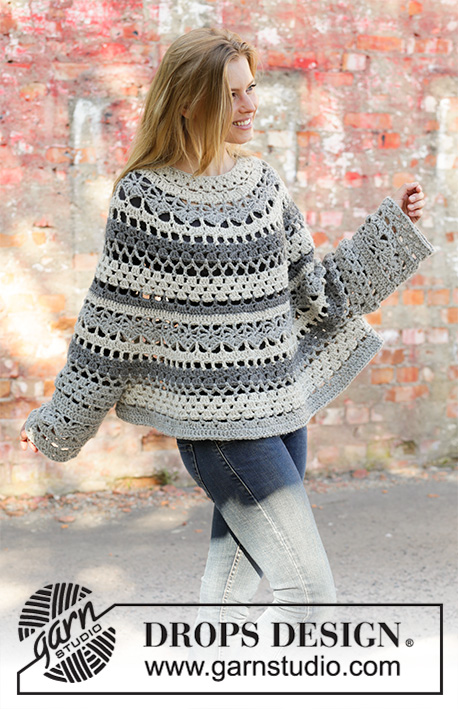 |
|||||||||||||||||||||||||||||||||
Crocheted poncho-sweater in DROPS Nepal. The piece is worked top down with lace pattern and stripes. Sizes S – XXXL.
DROPS 195-27 |
||||||||||||||||||||||||||||||||||
|
------------------------------------------------------- EXPLANATIONS FOR THE PATTERN: ------------------------------------------------------- PATTERN: See diagrams A.1 to A.6. CROCHET INFORMATION: Diagram A.1 shows how the rounds start and finish and is worked in addition to A.2. Diagram A.3 shows how the rounds start and finish and is worked in addition to A.4. Diagram A.5 shows how the rounds start and finish and is worked in addition to A.6. STRIPES: The piece is worked in stripes, see numbers 1-3 in the diagrams. 1 = light grey 2 = grey 3 = medium grey INCREASE TIP: To work out how to increase evenly, count the total number of stitches (e.g. 96 stitches) and divide by the number of increases to be made (e.g. 48) = 2. In this example, increase by working 2 double crochets around the same stitch after every 2nd double crochet. ------------------------------------------------------- START THE PIECE HERE: ------------------------------------------------------- PONCHO-SWEATER - SHORT OVERVIEW OF THE PIECE: The piece is worked in the round, top down. The sleeves are worked in the round. The neck is worked in the round to finish. YOKE: Work 112-119-126 chain stitches with hook size 5.5 mm = US I/9 and light grey and form them into a ring with 1 slip stitch in the first chain stitch. Work 3 chain stitches, 1 double crochet in each of the first 6 chain stitches, * skip 1 chain stitch, work 1 double crochet in each of the next 6 chain stitches *, work from *-* a total of 15-16-17 times and finish with 1 slip stitch in the 3rd chain stitch at the beginning of the round = 96-102-108 double crochets + 3 chain stitches. Then work pattern in STRIPES – read description above, as follows: Read CROCHET INFORMATION, work A.2A a total of 16-17-18 times on the round – on the round marked with an arrow increase 48-54-60 double crochets evenly – read INCREASE TIP = 144-156-168 double crochets. REMEMBER THE CROCHET GAUGE! A.2A is now repeated 24-26-28 times in width. When A.2A has been completed, work A.2B over A.2A – on the round marked with an arrow increase 48-54-60 double crochets evenly = 192-210-228 double crochets. A.2B is now repeated 32-35-38 times in width. When A.2B has been completed, work A.2A over A.2B – on the round marked with an arrow increase 48-54-60 double crochets evenly = 240-264-288 double crochets. A.2A is now repeated 40-44-48 times in width. Continue until A.2A has been worked in height = 80-88-96 chain-spaces. The piece measures approx. 36 cm = 14 1/4”. Now divide for the body and sleeves by inserting 4 markers in the piece as follows: Insert 1 marker after the first 13-15-16 chain-spaces (= half back piece), insert 1 marker after the next 14-14-16 chain-spaces (= sleeve), insert 1 marker after the next 26-30-32 chain-spaces (= front piece), insert 1 marker after the next 14-14-16 chain-spaces (= sleeve) and there are now 13-15-16 chain-spaces left on the round (= half back piece).Body and sleeves are divided at the markers. BODY: = 52-60-64 chain-spaces. Work A.2B over these stitches AT THE SAME TIME on the first round increase 24 double crochets evenly (A.2B is now repeated 30-34-36 times in width) = 180-204-216 double crochets – and on the round marked with an arrow increase 36-42-48 double crochets evenly = 216-246-264 double crochets (A.2B is now repeated 36-41-44 times in width). When A.2B has been completed, work with grey to finished length. Then work A.2C over A.2B a total of 0-1-2 times in height. Cut and fasten the strand. The body measures approx. 8-12-16 cm = 3 1/8”-4 3/4”-6 1/4” from the division. SLEEVE: = 14-14-16 chain-spaces. The sleeve is worked in grey to finished length. Start mid under the sleeve and continue as follows: Remember CROCHET INFORMATION, work A.2B a total of 7-7-8 times on the round, but without increasing. When A.2B is finished, work A.4A over A.2B. Then work A.4B over A.4A a total of 1-1-2 times in height. Cut and fasten the strand. The sleeve measures approx. 21-21-25 cm = 8 1/4”-8 1/4”-9 3/4” from the division. Work the other sleeve in the same way. NECK: The neck is worked in light grey. Work around the neck as follows – NOTE: You work in the chain stitches where there are double crochets, but do not work in the chain stitches which were missed out: Start mid back, fasten the strand with 1 slip stitch in a double crochet, work 1 chain stitch, 1 single crochet in the next double crochet, 3 chain stitches, skip 3-1-3 double crochets, 1 single crochet in the next double crochet, * 3 chain stitches, skip 3 double crochets, 1 single crochet in the next double crochet *, work from *-* a total of 22-24-25 times, work 3 chain stitches, skip 3 double crochets and finish with 1 slip stitch in the first chain stitch at the beginning of the round = 24-26-27 chain-spaces. Then work A.6 in the round – remember the CROCHET INFORMATION. When A.6 has been finished cut and fasten the strand. |
||||||||||||||||||||||||||||||||||
Diagram explanations |
||||||||||||||||||||||||||||||||||
|
||||||||||||||||||||||||||||||||||

|
||||||||||||||||||||||||||||||||||
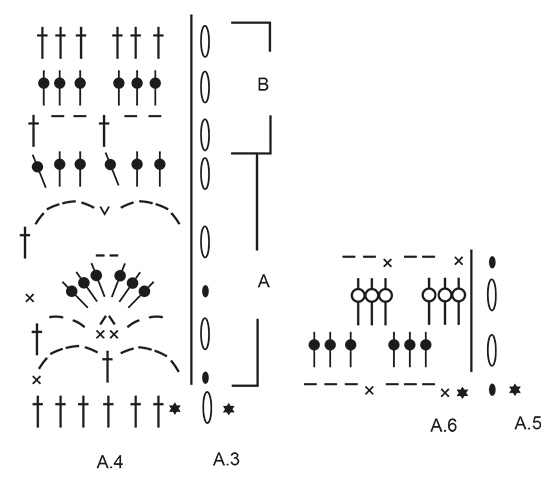
|
||||||||||||||||||||||||||||||||||

|
||||||||||||||||||||||||||||||||||
|
Have you made this or any other of our designs? Tag your pictures in social media with #dropsdesign so we can see them! Do you need help with this pattern?You'll find tutorial videos, a Comments/Questions area and more by visiting the pattern on garnstudio.com. © 1982-2024 DROPS Design A/S. We reserve all rights. This document, including all its sub-sections, has copyrights. Read more about what you can do with our patterns at the bottom of each pattern on our site. |
||||||||||||||||||||||||||||||||||







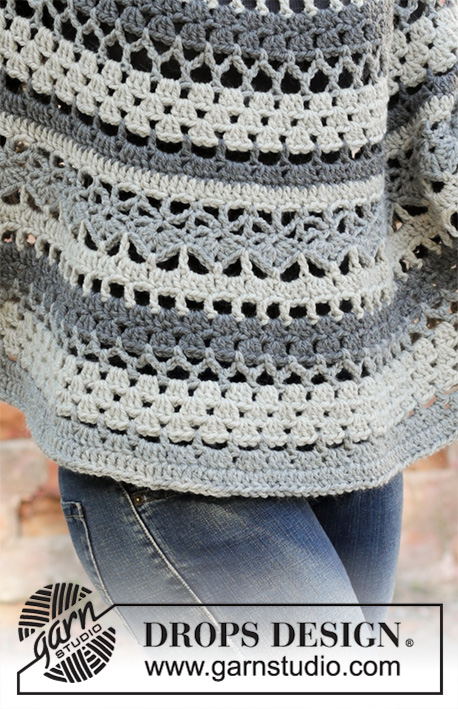

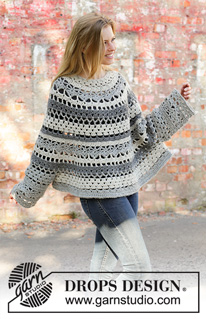
















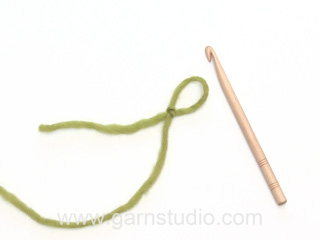

















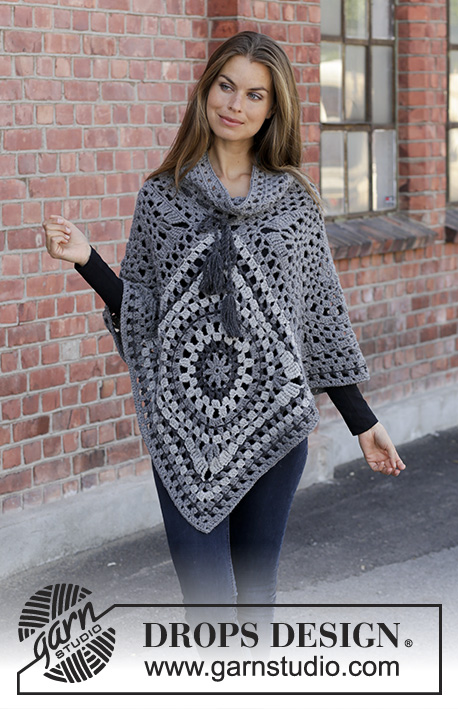






Comments / Questions (31)
Bonsoir, pouvez-vous me dire ou commence A2a, A2b et A2c. Je suis un peu perdu. Merci et bonne soirée.
11.01.2022 - 20:59DROPS Design answered:
Bonjour Mme Jaulin, retrouvez les délimitations des différentes parties du diagramme A.2 à droite de A.1, soit: A.2 A = 10 rangs; A.2B = 6 rangs et A.2C = 3 rangs. Bon crochet!
12.01.2022 - 07:20How many skeins are needed to complete this pattern in a medium size?
18.12.2021 - 18:44DROPS Design answered:
Dear Blair, you need 13 skeins in total to work this sweater: 6 in grey, 5 in light grey and 2 in medium grey. Happy crochetting!
18.12.2021 - 20:50Ho acquistato filato Nepal per fare il maglione poncho negli schemi quando c’è uno spazio bianco tra un simbolo e l’altro non devo fare nessun punto? Così però mi sembra di perdere punti e quindi la larghezza del lavoro; nello schema A.2 ad esempio quando devo usare per la seconda volta il filato n.1 Grazie
19.04.2021 - 10:17DROPS Design answered:
Buonasera Silvia, ad ogni simbolo corrisponde una maglia. Buon lavoro!
19.04.2021 - 22:26Hola! Como se hacen los aumentos en la prenda? O en el diagrama Ya están incluidos los aumentos? Como es que se hacen si los puntos altos van alrededor de un arco? Gracias
20.06.2020 - 18:59DROPS Design answered:
Hola Ana, las filas en las que hay que trabajar aumentos están marcadas con flechas en el diagrama A.1. El número de puntos que hay que aumentar está indicado en el texto del patrón. Estos aumentos se trabajan como se explica en el TIP PARA AUMENTAR, es decir, para aumentar 1 punto alto, trabajar 2 puntos altos en el mismo punto/arco.
21.11.2020 - 23:20Ich bin mit dem Poncho fast fertig. Im Diagramm der Anleitung steht eine Länge von 48 cm. Das ist knapp unterm Bauchnabel. Auf den Bildern wirkt der Poncho deutlich länger. Hab ich da was falsch verstanden? Auch die Ärmel sind kürzer wie auf den Bildern. Zieht sich das noch? Am Rumpf fehlen gut noch 10cm. Weiß nicht wie ich jetzt weiter machen soll. Noch einen Mustersatz unten dran? Mit oder ohne Zunahme??? Hiiilfeeeeee
14.06.2020 - 08:05DROPS Design answered:
Liebe Frau Heizmann, stimmte Ihre Maschenprobe in der Höhe? dh 8 Reihen Stäbchen = 10 cm. Gerne können Sie Ihr strickstück Ihr Laden zeigen, gerne kann man Ihnen dort am besten helfen (auch telefonisch oder per Email). Viel Spaß beim häkeln!
15.06.2020 - 09:43Hi, I would like to know how to end the row? I'm not sure if I must slip stitch and where. Please help.
10.09.2019 - 18:20DROPS Design answered:
Dear Chantelle, diagrams A.1, A.3 and A.5 shows how to start and how to finish each round in A.2, A.4 and A.6: you will either work 1 chain or 3 chains (see 9th and 10th symbol) and finish each round with 1 sl st in the first or 3rd ch from the beg of the round. Happy crocheting!
11.09.2019 - 07:44Me parece excelente el trabajo y muy clara la explicación.Me encantó. Felicitaciones
07.05.2019 - 19:59Is this pattern written out anywhere? Not use to using the diagrams. I would really like to make th I s poncho. Thanks!
10.04.2019 - 18:58DROPS Design answered:
Dear Elizabeth, we are sorry, but we do not have a written out pattern for the lace of this piece. There is the chart, and detailed explanation of the symbols, and you can always ask the help of the store you bought your DROPS yarn from for presonal help to make sense of it. Just follow the diagram, and it will be fine. Happy Knitting!
11.04.2019 - 09:00Vanaf het punt waar de mouwen starten moet je bij het lijf meteen in de eerste toer 24 stokjes meerderen in de lussen. De volgende toer haak je setjes van 3 stokjes tussen de setjes van de vorige toer (bij mij setjes van 4 en 3 stokjes). Dan ga je toch weer terug naar het aantal stokjes dat je had voordat je meerderde? Of doe ik iets verkeerd?
29.03.2019 - 17:12DROPS Design answered:
Dag Petra,
Op de eerste toer van A.2b meerder je 24 stokjes,dus A.2b wordt dan 30-34-36 keer herhaald, dus 180-204-216 stokjes (hier zijn de meerderingen al in verwerkt. Als je daarna nog eens 36-42-48 stokjes meerdert in de 4e toer (toer met pijl) kom je op 216-246-264 stokjes.
10.04.2019 - 09:25Est ce que l on peut faire les manches plus haut ? Merci cordialement
16.03.2019 - 08:43DROPS Design answered:
Bonjour Mivian, vous pouvez naturellement modifier le modèle à votre guise, nous ne sommes malheureusement pas en mesure de pouvoir adapter chaque modèle à chaque demande, mais contactez le magasin où vous avez acheté votre laine - même par mail ou téléphone - pour toute assistance complémentaire. Bon crochet!
18.03.2019 - 12:31